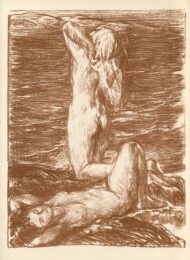


Charles Haslewood Shannon, (26 April 1863 – 18 March 1937), English artist, was born at Sleaford in Lincolnshire, the son of the Rev. Frederick William Shannon, Rector of Quarrington. Shannon attended the City and Guilds of London Art School and was subsequently considerably influenced by his lifetime partner Charles Ricketts and by the example of the great Venetians. In his early work he was addicted to a heavy low tone, which he abandoned subsequently for dearer and more transparent colour. He achieved great success with his portraits and his Giorgionesque figure compositions, which are marked by a classic sense of style, and with his etchings and lithographic designs. Several of his portrait works are on display in the National Portrait Gallery in London. Complete sets of his lithographs and etchings have been acquired by the British Museum and the Berlin and Dresden print rooms.
He was awarded a first-class gold medal at Munich in 1895 and a first-class silver medal in Paris in 1900. He was a member of the International Society of Sculptors, Painters and Gravers. Shannon became disabled in 1928 after a fall while hanging a picture, and the neurological damage that resulted caused amnesia and ended his career.